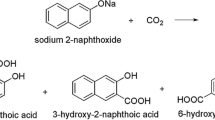Abstract
The electronic structure of a nickel(II)-acetylene complex is calculated according to the Wolfsberg-Helmholtz procedure in order to explain the catalytic action of nickel(II)-complexes in the tetramerization of acetylene. The calculations show that this action very likely arises from the partial transfer of the unpaired electrons of the nickel ion to two acetylene ligands. This transfer occurs when the appropriate ligands assume a specific geometrical position.
Zusammenfassung
Die Elektronenstruktur eines Nickel(II)-Acetylen-Komplexes wird nach dem Verfahren von Wolfsberg-Helmholtz berechnet, um die katalytische Wirkung von Ni2+-Komplexen bei der Tetramerisierung von Acetylen zu klären. Die Rechnungen zeigen, daß diese Wirkung wahrscheinlich auf dem teilweisen Übergang der ungepaarten Elektronen des Nickelions auf zwei Acetylen-Liganden beruht. Dieser Übergang findet statt, wenn diese Liganden eine bestimmte geometrische Lage einnehmen.
Résumé
La structure électronique d'un complexe de nickel-(II)-acétylène est calculée à l'aide de la méthode Wolfsberg-Helmholtz en vue d'expliquer l'effet catalytique de complexes de Ni2+ dans la tétramerisation d'acétylène. D'après les calculs il semble que l'effet arrive d'une transition partielle des électrons non appariés aux ligands d'acétylène. La transition apparaît quand ces ligands sont dans une position geometrique déterminée.
Similar content being viewed by others
Literatur
Reppe, W., O. Schlichting, K. Klager u. T. Toepel: Liebigs Ann. Chem.560, 1 (1948); vgl. auch J. W. Reppe, Acetylen Chemistry. New York: C. A. Meyer & Co 1949.
Schrauzer, G. N.: (insbes.) Angew. Chemie76, 28 (1964).
Wolfsberg, M., and L. Helmholtz: J. chem. Physics20, 837 (1952).
Mulliken, R. S.: J. chem. Physics23, 1833 (1955).
Nieuwland, J. A., W. S. Calcott, F. B. Downing, and A. S. Carter: J. Amer. chem. Soc.53, 4197 (1931).
Reppe, W., u. W. J. Schweckendiek: Liebigs Ann. Chem.560, 104 (1948).
Schrauzer, G. N.: J. Amer. chem. Soc.81, 5310 (1959).
Clementi, E., and D. L. Raimondi: J. chem. Physics38, 2686 (1963).
Watson, R. E.: Physic. Rev.119, 1934 (1960).
Zerner, M., and M. Gouterman: Theoret. chim. Acta (Berl.)4, 44 (1966).
Basch, H., A. Viste, and H. B. Gray: Theoret. chim. Acta (Berl.)3, 458 (1965).
Ballhausen, C. J., and H. B. Gray: Molecular orbital theory, p. 125. New York: W. A. Benjamin Inc. 1964.
Al Joboury, M. I., and D. W. Turner: J. chem. Soc. (London)1964, 4434.
Author information
Authors and Affiliations
Rights and permissions
About this article
Cite this article
Reinsch, E.A. Theoretische Überlegungen zur Cyclooctatetraensynthese nach Reppe. Theoret. Chim. Acta 11, 296–306 (1968). https://doi.org/10.1007/BF00568787
Received:
Issue Date:
DOI: https://doi.org/10.1007/BF00568787




